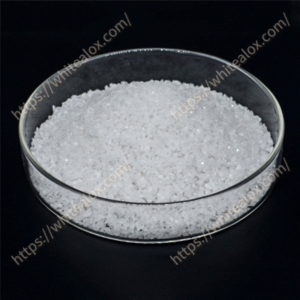White Fused Alumina (WFA) as a Blasting Abrasive: A Comprehensive Guide
White Fused Alumina is a high-performance, synthetic abrasive made from purified alumina (Al₂O₃) through an electric arc furnace process. It is renowned for its exceptional hardness and purity, making it a premium choice for demanding surface treatment applications.
| Typical Chemical composition | |
| AL2O3 | 99.3%min |
| SiO2 | 0.06% |
| Na2O | 0.3%max |
| Fe2O3 | 0.05%max |
| CaO | 0.04%max |
| MgO | 0.01%max |
| K2O | 0.02#max |
| Typical physical properties | |
| Hardness: | Mohs:9.0 |
| Maximum service temperature: | 1900 ℃ |
| Melting Point: | 2250 ℃ |
| Specific Gravity: | 3.95g/cm3 |
| Volume density | 3.6g/cm3 |
| Bulk density(LPD): | 1.75-1.95 g/cm3 |
| Color: | White |
| Particle shape: | Angular |
| Available size: | |
| F8# F10# F12# F14# F16# F20# F22# F24# F30# F36# F46# F54# F60# F70# F80# F90# F100# F120# F150# F180# F220# | |
Core Advantages and Characteristics
-
High Purity and Hardness
-
Composition: Typically contains 99%+ Aluminium Oxide (Al₂O₃).
-
Hardness: Mohs hardness of 9.0, second only to diamond and silicon carbide. This gives it excellent cutting speed and the ability to treat very hard materials.
-
-
Sharp and Durable Grains
-
The grains are angular and blocky, providing a sharp cutting edge.
-
It has high toughness and wear resistance, meaning the grains break down slowly. They undergo “micro-fracturing,” exposing new sharp edges (self-sharpening), which maintains consistent cutting performance throughout its lifespan.
-
-
Chemically Inert
-
WFA is resistant to acids and alkalis. It does not react with the workpiece surface, preventing contamination.
-
-
Low Surface Contamination
-
This is one of its most critical advantages. Its high purity ensures no iron impurities or other contaminants are embedded into the workpiece. This is essential for stainless steel, titanium, and aluminum to prevent rust spots or “flash rust.”
-
-
Reusable and Economical in the Long Run
-
Due to its high durability, WFA can be recycled and reused multiple times in closed-loop blasting systems. While the initial cost is higher than other abrasives, its longevity can make it more cost-effective overall.
-
Key Benefits in Application
-
Superior Surface Preparation: Creates a perfectly clean, uniform, and matte (satiny) surface profile, ideal for subsequent processes like painting, plating, or coating. It dramatically improves coating adhesion.
-
Effective for Deburring and Finishing: Its sharp edges efficiently remove burrs, flashes, and old coatings without excessive base material removal.
-
Ideal for Delicate and Precision Parts: Allows for precise control over the surface finish. It is less aggressive than steel shot and will not cause warping or dimensional changes to thin or precision components.
-
Safe and Environmentally Friendly: It is free of crystalline silica (SiO₂), eliminating the risk of silicosis, a serious lung disease associated with sandblasting using quartz sand.
Common Applications
WFA is the preferred choice for high-value, high-precision, and contamination-sensitive work:
-
Surface treatment of stainless steel, titanium, aluminum, and copper alloys (e.g., for architectural components, kitchenware, aerospace parts).
-
Pre-treatment for electroplating, thermal spray, and painting to ensure maximum coating adhesion.
-
Deburring and cleaning of precision parts, medical instruments, and automotive components.
-
Cleaning and restoring molds (e.g., for plastic, glass, or rubber) without damaging their precise dimensions.
-
Creating a uniform matte finish on glass and stone.


